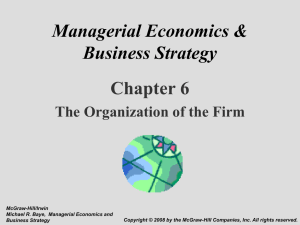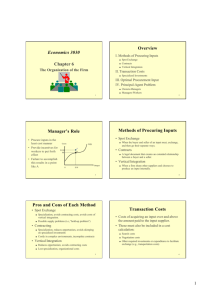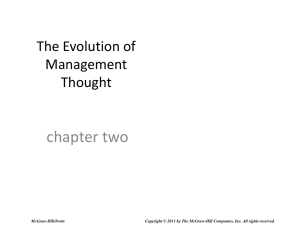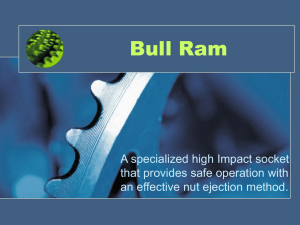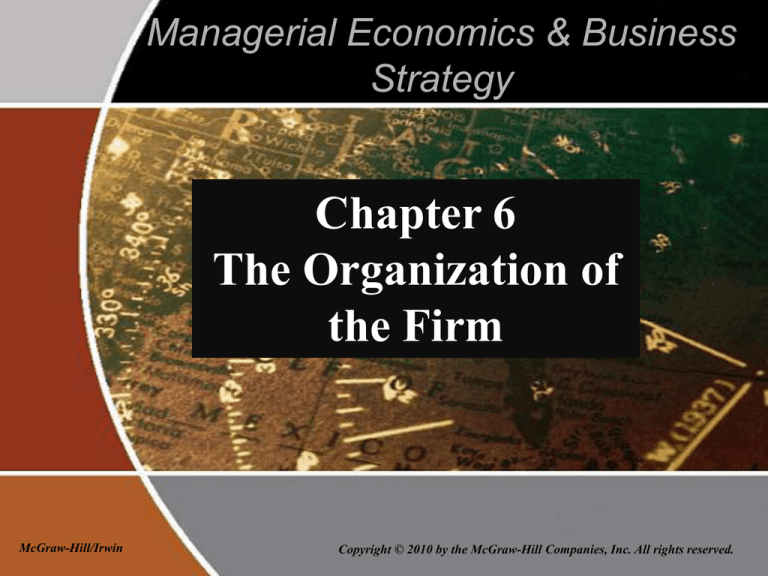
Managerial Economics & Business
Strategy
Chapter 6
The Organization of
the Firm
McGraw-Hill/Irwin
Copyright © 2010 by the McGraw-Hill Companies, Inc. All rights reserved.
Overview
I. Methods of Procuring Inputs
– Spot Exchange
– Contracts
– Vertical Integration
II. Transaction Costs
– Specialized Investments
III. Optimal Procurement Input
IV. Principal-Agent Problem
– Owners-Managers
– Managers-Workers
6-2
Procuring Inputs
What is the optimal way to acquire the efficient
mix of inputs?
How does the firm assure it is operating on the
cost function?
Least cost must be applied to methods of
obtaining inputs as well as their use.
How can the owners of a firm make sure that
workers are putting forth maximum effort?
6-3
Manager’s Role
Procure inputs in the
least cost manner, like
point B.
Provide incentives for
workers to put forth
effort.
Failure to accomplish
this results in a point
like A.
Achieving points like B
managers must
– Use all inputs efficiently.
– Acquire inputs by the
least costly method.
Costs
C(Q)
A
$100
80
B
Q
0
10
6-4
Methods of Procuring Inputs
Spot Exchange
– When the buyer and seller of an input meet,
exchange, and then go their separate ways.
– Buyer and sellers are anonymous.
– No legal relationship between the buyer and
seller.
– Advantage – specialization
– Used when inputs are standardized and there
exist many potential suppliers.
6-5
Methods of Procuring Inputs
Contracts
– A legal document that creates an extended
relationship between a buyer and a seller over a
specific period of time.
– Allows specialization for both sides involved in a
contract.
– Works well when contract specification is easy.
– Disadvantage – costly to write and cover all
contingencies.
– In complex environments contracts will be
incomplete
6-6
Methods of Procuring Inputs
Vertical Integration
– When a firm shuns other suppliers and chooses to
produce an input internally.
– Loses gains of specialization
– Firm has to manage both inputs and output.
– Advantage – no longer reliant on others for inputs
– Smart plant - JIT
– River Rouge - VI
6-7
Key Features
Spot Exchange
– Specialization, avoids contracting costs, avoids
costs of vertical integration.
– Possible “hold-up problem.”
Contracting
– Specialization, reduces opportunism, avoids
skimping on specialized investments.
– Costly in complex environments.
Vertical Integration
– Reduces opportunism, avoids contracting costs.
– Lost specialization and may increase
organizational costs.
6-8
Transaction Costs
Costs of acquiring an input over and above
the amount paid to the input supplier.
Includes:
– Search costs.
– Negotiation costs.
– Other required investments or
expenditures.
Some transactions are general in nature
while others are specific to a trading
relationship.
6-9
Transaction Costs
Specialized investment – expenditure that
allows exchange but has little or no alternative
use.
Generally specialized investments are sunk
costs.
Relationship specific exchange – one or both
parties have made a specialized investment.
Boeing /Airbus – Rolls Royce – General Electric
– Pratt & Whitney
6-10
Specialized Investments
Types of specialized investments:
– Site specificity – locating physical plants in close
proximity.
– Coal fired electricity generators and mines;
– trans-shipment facilities close to ports;
– auto parts manufacturers and auto assembly plants.
– Physical-asset specificity – capital equipment
needed to produce an input needed by a specific
buyer cannot be used to produce an input for
another buyer.
– Automobile headlamps
6-11
Specialized Investments
– Dedicated assets – investments made to enable
exchange with a specific buyer.
– Occurs many times in government procurement.
– Human capital – skills non-transferable to other
uses.
– Government procurement again is a good example.
6-12
Specialized Investments
Lead to higher transaction costs
– Costly bargaining – implies only a few parties are
prepared for a trading relationship.
– No market price for the input.
– Both sides negotiate a price.
– Parties may engage in strategic behavior.
– Underinvestment – less interest in quality as the
relationship may be short term.
6-13
Specialized Investments
Opportunism and the hold-up problem – attempting to
take advantage of the firm making a specialized
investment by taking advantage of the investment’s sunk
nature.
Makes firms reluctant to engage in relationshipspecific investments unless contracts can be structured
to mitigate this problem.
If both parties are required to make specialized
investments both may engage in opportunism.
Higher transactions costs to avoid this scenario.
6-14
Spot Exchange
Many buyers and sellers
Few transactions costs
Opportunism may occur if specialized
investments are part of the production
process.
May need to bargain each time an input is
purchased.
6-15
Contracts
Requires up-front expenditures
Input prices can be specified before specialized
investments are made.
Longer term commitment allows both buyer and seller
to invest in quality specialized investments.
Where the gains from opportunism are large, contracts
are needed.
6-16
Contracts
How long should a contract last?
Depends on MC and MB of extending the
contract.
MC of extending contract length increase as
contracts become longer because of the greater
array of possible contingencies.
Economies are dynamic; business conditions
change.
MC of contract length is upward sloping.
6-17
Contracts
MB of extending a contract is the Transactions Costs
avoided including opportunism and bargaining.
Optimal contract length increases when level of
specialized investment required to facilitate an
exchange increases.
As inputs become more standardized and economic
environment more certain, MC of writing longer
contracts decreases leading to longer contracts and vice
versa.
6-18
Specialized Investments
and Contract Length
$
MC
MB1
Due to greater need for
specialized investments
MB0
Longer Contract
0
L0
L1
Contract
Length
6-19
Specialized Investments
and Contract Length
$
More complex
contracting
environment
MC2
MC0
MB0
Shorter Contract
0
L2
L0
Contract
Length
6-20
Specialized Investments
and Contract Length
$
MC0
MC1
Less complex
contracting
environment
MB0
Longer Contract
0
L0
L0
Contract
Length
6-21
Vertical Integration
Benefits:
Ideal when specialized investments generate
transactions costs
Or the product is very complex
Or the economic environment is plagued by uncertainty
Firm moves up the production stream and produces
increasingly basic inputs.
Firm avoids the middleman.
Reduces opportunism
6-22
Vertical Integration
Disadvantages:
Market discipline is replaced by internal regulatory
mechanism.
Firm no longer specializes in what it does best.
Vertical integration should be viewed as a last resort
only when spot exchange or contracts are not suitable or
have failed.
6-23
Optimal Input Procurement
No
Substantial
specialized
investments
relative to
contracting costs?
Yes
No
Contract
Spot Exchange
Complex contracting
environment relative to
costs of integration?
Yes
Vertical
Integration
6-24
The Principal-Agent Problem
How to compensate labor inputs to be sure they are
putting out their best effort.
Occurs when the principal cannot observe the effort of
the agent.
– Example: Shareholders (principal) cannot observe
the effort of the manager (agent).
– Example: Manager (principal) cannot observe the
effort of workers (agents).
The Problem: Principal cannot determine whether a
bad outcome was the result of the agent’s low effort or
due to bad luck.
6-25
The Principal-Agent Problem
Separation of ownership and control
This creates a fundamental incentive
problem.
Does a poor year mean low effort or bad
luck or poor demand for the product?
Manager wants to earn income but is also
enticed by leisure.
How much leisure (shirking) will the
manager do on the job?
6-26
The Principal-Agent Problem
Manager must recognize the existence of the
principal-agent problem and devise plans to
align the interests of workers with that of the firm.
Shareholders must create plans to align the
interest of the manager with those of the
shareholders.
6-27
Solving the Problem Between Owners
and Managers
Internal incentives
– Incentive contracts – what the manager does under
an incentive scheme depends on relative value of
work versus leisure.
– Stock options, year-end bonuses – if earnings are
largely tied to an incentive bonus then reducing
executive compensation is a mistake.
– Performance-based compensation benefit
stockholders as well as executives.
– Reducing incentives will reduce profits.
6-28
Solving the Problem Between Owners and
Managers
External incentives outside the firm
– Personal reputation – increased job mobility if
managerial excellence is recognized.
– Threat of takeover – if profits are not being
maximized then another firm could do a buyout and
replace management.
– Even a manager working under a fixed salary would
have the incentive to do a better job.
6-29
Solving the Problem Between Managers
and Workers
Difficulty in monitoring effort so make income dependent
on performance.
Profit sharing – tying compensation to the underlying
profitability of the firm.
Revenue sharing – linking compensation to the
underlying revenues of the firm. (tips, sales
commissions).
These do not provide an incentive for workers to
minimize costs.
6-30
Solving the Problem Between Managers and Workers
Piece rates – pay depends on output produced. To earn
more one has to produce more.
Effort must be expended in quality control
Time clocks – not very useful in dealing the principalagent problem. Do not monitor effort.
Spot checks – allows monitoring of presence, effort,
and quality.
Must be random to be effective and frequent enough so
that workers are concerned about demonstrating
performance.
Threats work differently psychologically than
performance bonuses.
6-31
Conclusion
The optimal method for acquiring inputs
depends on the nature of the transactions
costs and specialized nature of the inputs
being procured.
To overcome the principal-agent problem,
principals must devise plans to align the
agents’ interests with the principals.
6-32

